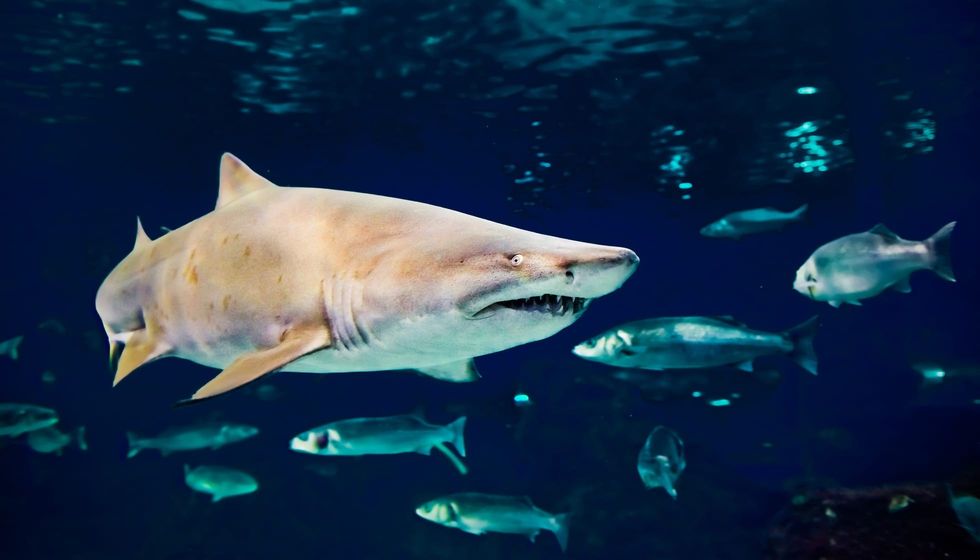Sharks are very popular marine predators and have widely gained notoriety as mean villains through movies and cartoons. The sand tiger shark, Carcharias taurus, is also known by the name blue nurse sand tiger shark or spotted a ragged tooth shark.
They are called grey nurse sharks in Australia. Tiger sand sharks are widely distributed across the globe. Common sand tiger shark habitats are subtropical, tropical, and temperate waters.
The sand tiger shark species are threatened due to extensive commercial fishing. They are fished widely in regions like Japan. This species of shark only reproduce once every two to three years, and the population is not maintained.
Their conservation status is listed as Vulnerable. Adult sand tiger sharks have no known predators. The juvenile sand sharks are fed on by other sharks like great white sharks, shortfin mako sharks, tiger sharks, and bull sharks.
Read on to know more. You may also check out the fact files on blacktip shark and nurse shark from Kidadl.
Sand Tiger Shark Interesting Facts
What type of animal is a sand tiger shark?
A sand tiger shark or a gray nurse shark, Carcharias taurus, is a species of shark, a marine cartilaginous fish. They belong to the family Odontaspididae. The name Carcharias taurus literally means bull shark but do not mistake them for a different species known as bull shark (Carcharhinus leucas).
What class of animal does a sand tiger shark belong to?
The sand tiger shark, also known as the gray nurse shark belongs to the class of cartilaginous fish known as Chondrichthyes. They are taxonomically classified as kingdom Animalia, phylum Chordata, class Chondrichthyes, order Lamniformes, family Odontaspididae, genus Carcharias, and species Taurus.
They are closely related to other Lamniforme sharks like the basking shark, the goblin shark, and the Megalodon shark (a prehistoric species of sharks).
How many sand tiger sharks are there in the world?
The current population and population trend are unknown. They are very vulnerable and the population is declining due to excessive commercial fishing and low birth rates.
Where does a sand tiger shark live?
Sand tiger sharks live in subtropical and temperate oceans like the Atlantic Ocean, the Indian Ocean, and the Pacific Ocean. They love the warm seas.
The sand tiger sharks are distributed globally. Their distribution ranges from Argentina to the Gulf of Maine in the western Atlantic. In the eastern Atlantic, they are found in the waters of the coast of Europe.
The sand tiger sharks also live in the Mediterranean Sea close to North Africa. Other distribution includes from Australia to Japan in the west Pacific, Eastern Pacific, and off the coasts of South Africa.
What is a sand tiger shark's habitat?
The sand tiger sharks are found to inhabit temperate, subtropical, and tropical waters. They live in shallow waters, surf zones, shallow bays, and near coral reefs. They are capable of diving as deep as 626 ft (191 m).
The sand tiger sharks are also found near the bottom of the water column. During the breeding season, they swim closer to the sandy bottom floor. The sand tiger shark habitat is a piece of must-know information for aquarium owners.
Who do sand tiger sharks live with?
Sand tiger sharks are nocturnal species. During the daytime, they rest alone closer to the surface, in rocky caves and reefs. At night, they hunt in small groups. During summer, they migrate annually.
How long does a sand tiger shark live?
The sand tiger shark lifespan in the wild varies widely from anywhere between 15-40 years of age.
How do they reproduce?
The breeding season of the sand tiger sharks is from August to December in Northern Hemisphere and from August to October in the Southern Hemisphere (Australia). The male sharks show dominant behavior and intimidate other male sharks making them swim away.
As they become receptive, the female sharks shield themselves by hovering close to the sandy ocean floor. The male comes to the female and shows interest in mating by nibbling lightly with their teeth on their caudal fins and pectoral fins.
The female bites back if interested. This courtship behavior continues for days, the male smells the female cloaca daily and when the female is ready, they swim off and begin mating.
Females mate with multiple males in a breeding season. The male leaves after mating.
All Lamniformes have similar reproductive behavior. The female sand tiger shark initially has around 50 embryos in its yolk sac. When one embryo develops to a certain size, they feed on the underdeveloped embryos and this is intrauterine cannibalism.
The gestation period is 8-12 months, they give birth to a single healthy offspring and occasionally to two pups. The sand tiger shark reproduction place only once every two years or three years. Sand tiger sharks have the lowest reproductive rates and high infant mortality rates.
What is their conservation status?
The IUCN red list of threatened species 2009, has classified the conservation status of sand tiger sharks listed as Vulnerable. The major threat faced by this species of shark is overfishing and depletion of aquatic resources.
Sand Tiger Shark Fun Facts
What do sand tiger sharks look like?
The sand tiger shark has a pointy head and a conical flattened snout. Their streamlined body is plump, bulky, and gray in color. Reddish-brown spots cover their sides (in adults) and the underside is off-white. They have beady, round, small eyes and do not have eyelids. The sand tigers also lack a nictitating membrane that offers protection.
The mouth of sand tiger sharks is big and goes beyond their eyes. The sand tiger shark's jaw has three rows of sharp, pointed teeth that protrude out.
Even when their mouth is closed, the teeth are visible outside, which gives them their characteristic vicious look. Their teeth do not have any transverse serrations. The upper front teeth are separated by small intermediate teeth.
The anal and dorsal fins of a sand tiger shark are of the same size. This is a key identification characteristic of sand tiger sharks. The gray dorsal fins are large and broad, they extend beyond the pectoral fins.
The upper lobe of their tail is longer than the lower lobe. This facilitates swift movement. The male sand tiger shark has gray claspers with white tips.

How cute are they?
Sharks have a negative reputation for being aggressive and dangerous. They are considered to be anything but cute. Looks can be deceiving. Sand tiger sharks are non-aggressive and harmless unless they feel threatened. Sand tigers can harass and chase divers but do not inflict any fatal wounds.
How do they communicate?
Sand tiger sharks do not make any vocal sounds or noise, they lack vocal cords. Sand tiger sharks communicate through visual and sensory perceptions. Sand tigers have electroreceptors that help in sense nearby objects. Their later line helps feel vibrations in the water. They also arch their bodies to communicate with other sharks.
How big is a sand tiger shark?
The adult sand tiger shark length varies from 6.6-10.5 ft (2-3.2 m). They are only 3.7-4.9 ft (115-150 cm) long when they are born. Female sand tiger sharks are bigger than males.
How fast can a sand tiger shark swim?
The exact speed of the sand tiger shark is unknown. Sand tigers are great swimmers and can swim at an average speed of 2-3 mph (3.2-4.8 kph).
How much does a sand tiger shark weigh?
The sand tiger shark's weight ranges from 201-351 lb (91-159 kg).
What are the male and female names of the species?
There are no sex-specific names for the male and female species of sand tiger sharks. The male sand tigers are distinguished from the female by the presence of a sexual organ called claspers.
What would you call a baby sand tiger shark?
You can call sand tiger shark babies hatchlings as they hatch from eggs.
What do they eat?
The sand tiger sharks are top predators, and the sand tiger shark diet includes prey like bony fish, lobsters, crabs, sharks rays, squids, and other smaller sharks. Sand tigers are nocturnal feeders, and they hunt in groups.
They chase fish into small groups, round on them from all sides, and hunt. At times, they go on a feeding frenzy, attacking randomly. The sand tigers are very stealthy and are able to hunt at great depths far away from their daytime shelters.
Are they dangerous?
A misconception spread through thriller movies and stories is that sharks are extremely dangerous and attack humans. Though sand tigers appear to look ferocious with a mouth full of pointy, sharp sand tiger shark teeth, they are docile and non-aggressive.
They only attack humans as an act of self-defense, when they feel threatened and vulnerable. Sand tiger shark attacks are extremely rare. Sand tiger sharks cannot cause human fatality.
Would they make a good pet?
Many smaller species and subspecies of sharks are popular among aquarium owners. But larger species like sand tiger sharks are terrible pets.
Sand tiger sharks require huge tanks and this is very inconvenient to maintain at your home. Sand tiger sharks are extremely expensive to maintain and require very specific water conditions to survive. It is not illegal to own some species of sharks.
Did you know...
The sand tiger shark scientific name, Carcharias taurus, was disputed multiple times and changed to Odontaspis cuspidata, Odontaspis taurus, and Eugomphodus Taurus. Later, the ICZN (International Code of Zoological Nomenclature) accepted the current classification.
Smalltooth sand tiger shark (Odontaspis ferox) and bigeye sand tiger shark (Odontaspis noronhai) are entirely different species of mackerel shark and are not related to sand tiger sharks.
The sand tiger shark vs tiger shark, both belong to different orders. The tiger shark belongs to Carcharhiniformes.
Though generally shy, the sand tiger sharks steal fish and prey from the spears and nets of humans.
To escape from adult sharks who feed on the young ones, the pups spend their time together in nurseries. Great South Bay, a summer lagoon, near Long Island, Massachusetts’s Plymouth, Australia, and Duxbury Bays are few such identified habitat sand tiger shark nurseries.
Many sharks are often found near shipwreck sites.
What is the similarity between a sand tiger shark and a great white shark?
The sand tiger shark, Carcharias taurus, and the great white shark, Carcharodon carcharias, are both sharks and belong to the same order Lamniformes. They have five pairs of gill slits, a big mouth, two non-spiny dorsal fins, and they do not have nictitating membranes to protect their eyes, unlike other sharks.
How do sand tiger sharks maintain neutral buoyancy?
The sand tiger shark adaptations include maintaining neutral buoyancy by swimming to the surface and gulp air. This helps them turn their stomachs into air pockets and remain motionless in the water at great depths while hunting. Sand tiger sharks are the only shark species capable of doing this.
Here at Kidadl, we have carefully created lots of interesting family-friendly animal facts for everyone to discover! Learn more about some other fishes from our basking shark facts and great white shark facts pages.
You can even occupy yourself at home by coloring in one of our free printable sand tiger shark coloring pages.









